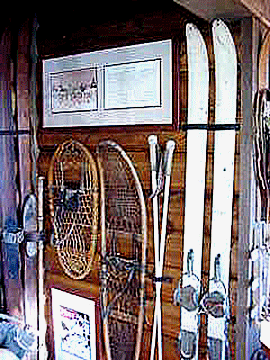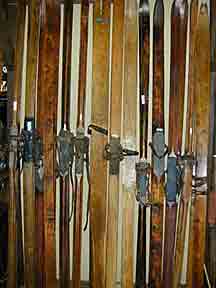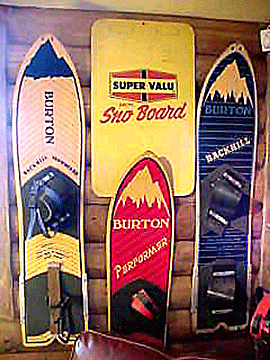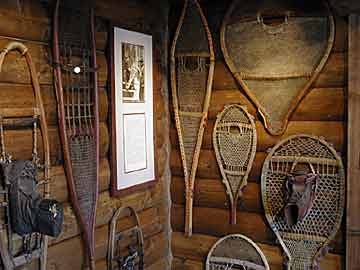Winter Sports Museum
Educates Visitors
by Bob
Brooke
 While all antique dealers
sell items from the past, few take advantage of them to teach their
customers a little about the items’ history. The folks at Ski Country
Antiques in Evergreen, Colorado, have done just that by creating a
winter sports museum right in their store. While all antique dealers
sell items from the past, few take advantage of them to teach their
customers a little about the items’ history. The folks at Ski Country
Antiques in Evergreen, Colorado, have done just that by creating a
winter sports museum right in their store.
Sure, customers can
sometimes find information on any antique if they want it, especially on
the Internet, but how many take the time to do it. Also, shops selling
unique items like the skis, skates, snowshoes that Ski Country Antiques
offers its patrons, often miss out on the fringe buyers–those who
might buy an item if they knew more about it or its relationship in
history.
So to educate their customers and potential
customers, sales manager Jeff Hume decided to create a small museum
within the shop. Brian Kleinwachter, the shop’s owner, had been
collecting old skis, skates and snowshoes for 10 years when Hume came up
with the idea for the museum at the end of 2001. "It was my idea to
arrange his collection so that our customers could understand about the
history of winter sports," said Hume. At first, Hume arranged the
items in a corner of the shop but as the collection grew, Brian decided
to renovate the entire front room for the museum with signs directing
customers to the shop in the back room.
 With winter sports gear being made of all sorts
of ultra modern materials like fiberglass and steel and aluminum, it’s
hard for some people to realize that all the equipment started out being
made by hand in a rather primitive way using natural materials. Even if
visitors don’t buy any antique equipment, they come away from Hume’s
museum with a better understanding of how it all began. With winter sports gear being made of all sorts
of ultra modern materials like fiberglass and steel and aluminum, it’s
hard for some people to realize that all the equipment started out being
made by hand in a rather primitive way using natural materials. Even if
visitors don’t buy any antique equipment, they come away from Hume’s
museum with a better understanding of how it all began.
So far, the museum contains 15 pairs of skis,
18 pairs of snowshoes, 20 pairs of skates and 12 snowboards. The
Scandinavians have used skis for transportation for a long time. It was
they who invented cross-country skiing, so it’s fitting that the
collection includes a pair of 11-foot-long, Swedish hunting skis, c.
1790-1830. Hume also has Norwegian downhill skis from the 1860s and
1880s. The museum’s collection includes a pair of 1920s jumping skis.
"The latest skis we have date from the 1940s when metal edges were
introduced," Hume said. "We also have a variety of ski poles,
including ones made of bamboo and hickory." One of the museum’s
prized pieces, according to Hume, is a pair of new, 5-foot, kids’ skis
made by Northland of Minneapolis and still in the box.
With 20 pairs of ice skates, the museum shows
their evolution nicely. Beginning with hand-forged Dutch skates with
blades that curl in front to thicker Dutch work skates from the 18th
Century with heavy blades for more stability, the display shows
customers how unsleek these pieces really were. "We then move up to
a pair of queen skates, with brass foot and heel plates and better
leather bindings," added Hume. "Skates with further
improvements in heel and foot plates, nail foot plates that a skater
could kick down and contoured shoe plates are also on display."
According to Hume, outfitting skates with
leather boots began in the 1920s and early 1930s, along with welded
steel blades. Two of the skate manufacturers represented are Barney and
Berry of Springfield, Massachusetts, and Planert, which made racing
speed skates. Hume also has on exhibit a pair of child’s figure skates
with white leather boot and a 1950s hockey skate with rigid leather boot
and steel toe.
Unless someone lives in the far North or at
higher altitudes out West where there are deeper snows throughout the
winter, they most likely aren’t familiar with snowshoes, according to
Hume. "The earliest snowshoe we have is a Native American pair with
a super tight weave, leather strap and bindings, and excellent
craftsmanship," Hume said. The museum also has pairs of Alaskan
Eskimo snowshoes, Canadian snowshoes, and U.S. military snowshoes in its
collection.
 But Hume’s first love is snowboarding and
even though the sport is relatively young, early
snowboards are already a hot collectible. Believe it or not,
snowboarding goes back all the way to 1929 when M.J. "Jack"
Butchett cut out a plank of plywood and secured his feet with a length
of clothesline and horse reins. It took another 30 years before anyone
took snowboarding seriously. In 1963, Tom Sims, then an eight grade
student, constructed what he called a "Ski Board" for a class
project. Hume displays an early Sims Blade Snowboard with high back
bindings in the museum. But Hume’s first love is snowboarding and
even though the sport is relatively young, early
snowboards are already a hot collectible. Believe it or not,
snowboarding goes back all the way to 1929 when M.J. "Jack"
Butchett cut out a plank of plywood and secured his feet with a length
of clothesline and horse reins. It took another 30 years before anyone
took snowboarding seriously. In 1963, Tom Sims, then an eight grade
student, constructed what he called a "Ski Board" for a class
project. Hume displays an early Sims Blade Snowboard with high back
bindings in the museum.
By 1965, Sherman Poppen had invented "The
Snurfer" as a toy for his kids by bolting two skis together. It
looked like a weird cross between a plywood sled and a skateboard.
"We have an original Snurfer, as well as a SnoSurfer," said
Hume. "We even have one called the Snookie, made by a company out
of White Bear Lake, Minnesota."
One of the earliest snowboards in the museum,
called a Skeeboggan, dates from 1930s and 1940s. It’s a metal board
with a shaft on a hinge that flips up from the front. And then there’s
the budget model, the Arctic Snoboard, made of fiberboard.
 Burton and Winterstick introduced the first
real ski technology for snowboards in 1980. Their new prototype had a
P-Tex base. And in 1982 the first international snowboard race was held
in Suicide Six, outside of Woodstock, Vermont. Hume is proud to display
three Burton boards which look drastically different from earlier
models. Burton and Winterstick introduced the first
real ski technology for snowboards in 1980. Their new prototype had a
P-Tex base. And in 1982 the first international snowboard race was held
in Suicide Six, outside of Woodstock, Vermont. Hume is proud to display
three Burton boards which look drastically different from earlier
models.
"We established the museum more for
education," he continued, "especially in the categories that
we sell–ice skates, skis and snowshoes–in our store. Having it has
helped sell some of the higher end items because people are a little
more educated to the range we do have. For instance, a pair of 1950s
Canadian snowshoes that are wood with cowhide cost only $60, while nicer
ones sell for $265 to $395. Since we opened the museum, those above $200
are selling better."
Ski Country Antiques’ Winter Sports Museum
has been so successful that Hume said they’re planning on adding more
space. "In the next couple of years, we’re planning a
14,000-square-foot addition to the shop, and I’m confident that the
museum will get an additional 400 square feet of space."
So whether dealers sell winter sports equipment
or specialize in glass, types of furniture, ceramics, or tools,
establishing a small museum can do wonders for business. Just ask Hume
and Kleinwachter.
<
Back to More Antiques to View
Next Article >
|
